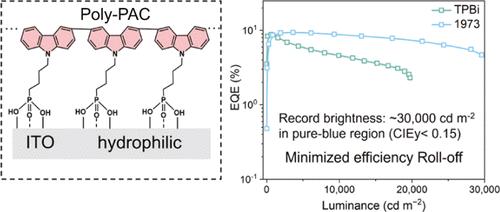基于膦酸功能化空穴注入层的超亮蓝铅卤化物钙钛矿发光二极管
IF 16
1区 材料科学
Q1 CHEMISTRY, MULTIDISCIPLINARY
引用次数: 0
摘要
与传统的溶液处理发光二极管相比,卤化铅钙钛矿发光二极管(PeLEDs)本质上能够在高电流密度下提供高效率。虽然这种性能和相关的高辐射度已经在绿色和近红外中得到了很好的证明,但由于极其严重的发光效率滚降,特别是在纯蓝色区域(<480 nm,低于0.15的CIEy坐标),蓝色pled远远落后。在这里,通过解决磷酸功能性卡唑(PACs)作为注孔层的关键限制,同时利用它们在注孔方面的优势,我们在高亮度下实现了效率滚降最小的超亮纯蓝色pled, CIEy坐标低于0.15。我们表明,基于流行的小分子pac的器件通常表现出显著的泄漏电流。这是由于由反胶束形成和薄膜卤化铅钙钛矿发射体的纳米岛结构造成的不均匀表面覆盖的协同效应。通过使用聚合物pac,我们展示了亮蓝色pled,其峰值亮度为~ 29 800 cd m-2 (478 nm, CIEy坐标低于0.15)。在脉冲驱动下,我们还实现了高达~ 140 000 cd m-2的高亮度。我们的研究不仅为开发亮蓝色pled提供了有用的指导,而且还解决了关于pac的界面特性及其对空穴传输的影响的长期难题,并有助于进一步设计用于卤化铅钙钛矿应用的这些材料。本文章由计算机程序翻译,如有差异,请以英文原文为准。

Ultrabright Blue Lead-Halide Perovskite Light-Emitting Diodes Based on Phosphonic Acid Functionalized Hole Injection Layer
Lead-halide perovskite light-emitting diodes (PeLEDs) are intrinsically capable of delivering high efficiency at high current densities compared to conventional solution-processed light-emitting diodes. While such performance and relevant high radiance have been well demonstrated in green and near-infrared ones, blue PeLEDs have lagged far behind due to extremely severe luminance-efficiency roll-off, especially in the pure-blue region (<480 nm, a CIEy coordinate below 0.15). Here, by tackling the critical limitations of phosphonic acid functional carbazoles (PACs) as hole injection layers and simultaneously leveraging their advantages on hole injection, we achieved ultrabright pure blue PeLEDs with minimized efficiency roll-off at high brightness with a CIEy coordinate below 0.15. We show that devices based on prevailing small-molecule PACs generally exhibit significant leakage currents. This is due to a synergistic effect of uneven surface coverage from reverse micelle formation and the nanoisland structure of thin-film lead-halide perovskite emitters. By using polymeric PACs instead, we demonstrate bright blue PeLEDs showing a peak luminance of ∼29 800 cd m–2 (478 nm, at a CIEy coordinate below 0.15). We also achieve a high brightness reaching ∼140 000 cd m–2 under pulsed driven. Our study not only provides a useful guidance for developing bright blue PeLEDs but also resolves a long-standing puzzle regarding the interfacial properties of PACs and their impact on hole transport, and it helps with the further design of these materials for lead-halide perovskite applications.
求助全文
通过发布文献求助,成功后即可免费获取论文全文。
去求助
来源期刊

ACS Nano
工程技术-材料科学:综合
CiteScore
26.00
自引率
4.10%
发文量
1627
审稿时长
1.7 months
期刊介绍:
ACS Nano, published monthly, serves as an international forum for comprehensive articles on nanoscience and nanotechnology research at the intersections of chemistry, biology, materials science, physics, and engineering. The journal fosters communication among scientists in these communities, facilitating collaboration, new research opportunities, and advancements through discoveries. ACS Nano covers synthesis, assembly, characterization, theory, and simulation of nanostructures, nanobiotechnology, nanofabrication, methods and tools for nanoscience and nanotechnology, and self- and directed-assembly. Alongside original research articles, it offers thorough reviews, perspectives on cutting-edge research, and discussions envisioning the future of nanoscience and nanotechnology.
 求助内容:
求助内容: 应助结果提醒方式:
应助结果提醒方式:


